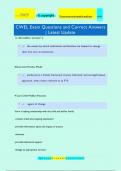2024 /2025 | © copyright | This work may not be copied for profit gain Excel!
CWEL Exam Questions and Correct Answers
| Latest Update
In child welfare, "practice" is
✓ -:- the means by which individuals and families are helped to change
their bxs and circumstances
Illinois Core Practice Model
✓ -:- anchored in a Family Centered, trauma informed, and strength based
approach, often times referred to as FTS
9 Core Child Welfare Practices
✓ -:- -agent of change
-form a helping relationship with the child and his/her family
-conduct initial and ongoing assessment
-provide information about the impact of trauma
-advocate
-provide behavioral support
-linkage to appropriate services
1|P a g e | G r a d e A + | 2 0 2 0 2 5
,2024 /2025 | © copyright | This work may not be copied for profit gain Excel!
-coordinate all child and family services
-cultural competence
Without family connectedness child is at risk for
✓ -:- instability, depression, and even unemployment and delinquency
Child and Family Team Meeting
✓ -:- center of casework activities and how all other staffings, or
mandatory case processes should have i nformation flowing from and back
to the CFTM. 5 key components.
CFTM 5 key components
✓ -:- Engagement, full disclosure, open participation, collaboration,
planning for permanency.
Adverse Childhood Experiences (ACEs)
✓ -:- growing up (prior to age 18) i n a household with stressful or
traumatic experiences, including abuse, neglect, and a range of household
dysfunction, such as witnessing domestic violence or growing up with
2|P a g e | G r a d e A + | 2 0 2 0 2 5
,2024 /2025 | © copyright | This work may not be copied for profit gain Excel!
substance abuse, mental disorders, parental discord, or crime in the
home, removal or displacement, three or more placements in an 18
month period.
Response to trauma throughout development: young children (2.5-6 years)
✓ -:- helplessness and passivity, generalized fear, confusion, difficulty
identifying what is bothering them, attrib uting magical qualities to
traumatic reminders, fighting or threatening bx, attention problems,
sadness/depression, separation anxiety, specific fears, low frustration
tolerance, hyperactive, moody, aggressive defiant, lying, learning
disabilities, social problems, suppressed immune system
Response to trauma throughout development: school age children (6-11 years)
✓ -:- physical complaints, bedwetting, school failure/absenteeism,
behavioral problems, attention problems, fighting or threatening bx, guilt
feelings, acting like a parent to siblings, depression, defiant, lying, stealing,
learning disabilities, inappropriate emotional responses, self -blame,
hypersensitivity to physical contact, difficulties coordinating and balancing
Response to trauma throughout development: adolescents (12-18 years)
3|P a g e | G r a d e A + | 2 0 2 0 2 5
, 2024 /2025 | © copyright | This work may not be copied for profit gain Excel!
✓ -:- antisocial bx, eating disorders, runaway, dating violence, depression,
suicidal, substance abuse, sleeping disorders, school failure, absenteeism,
relationship problems, acting like a parent to siblings, lose s time,
difficulty seeing a future for oneself
3 kinds of stress
✓ -:- positive stress, tolerable stress, toxic stress
postive stress
✓ -:- moderate, short lived stress responses
tolerable stress
✓ -:- More intense stress responses that allow enough tim e to recover, or
occur in a relatively safe environment with the presence of supportive
adults
toxic stress
✓ -:- Strong, frequent or prolonged activation of the body's stress
management system, without access to supportive adults
4|P a g e | G r a d e A + | 2 0 2 0 2 5




